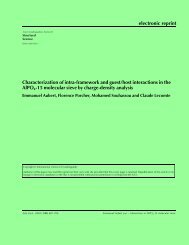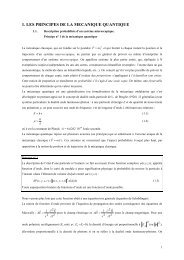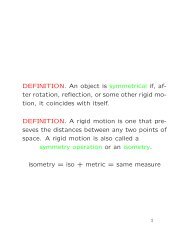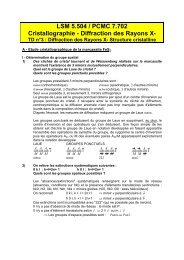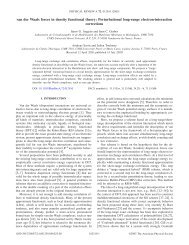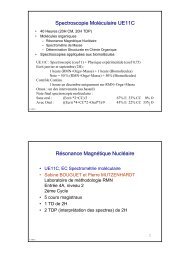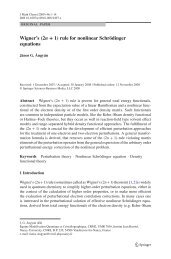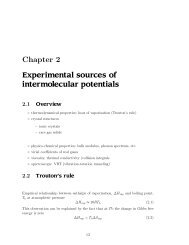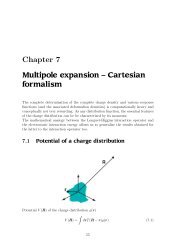Linear Response and Measures of Electron Delocalization ... - CRM2
Linear Response and Measures of Electron Delocalization ... - CRM2
Linear Response and Measures of Electron Delocalization ... - CRM2
Create successful ePaper yourself
Turn your PDF publications into a flip-book with our unique Google optimized e-Paper software.
<strong>Linear</strong> <strong>Response</strong> <strong>and</strong> <strong>Measures</strong> <strong>of</strong> <strong>Electron</strong> <strong>Delocalization</strong> Current Organic Chemistry, 2011, Vol. 15, No. 20 3613<br />
F<br />
Cl<br />
O<br />
O<br />
1.3489<br />
1.7571 1.4697 1.2269<br />
1.1630 N<br />
1.1738<br />
N<br />
P<br />
N<br />
O<br />
133.25<br />
o<br />
O<br />
O<br />
129.77<br />
o<br />
O<br />
O<br />
O<br />
O<br />
O<br />
O<br />
O<br />
S<br />
O<br />
1.1569<br />
1.1601<br />
1.7375<br />
1.2857<br />
1.2916<br />
C<br />
1.7336<br />
C<br />
C<br />
C<br />
F<br />
o<br />
F<br />
Cl<br />
108.27 113.20<br />
o<br />
Cl<br />
S<br />
S<br />
O<br />
O<br />
F<br />
Cl<br />
O<br />
O<br />
1.3010 1.7453 1.4050 1.4134<br />
B<br />
B<br />
S<br />
B<br />
F<br />
F<br />
Cl<br />
Cl<br />
O<br />
O<br />
O<br />
O<br />
Fig. (1). Schematic illustration <strong>of</strong> the family <strong>of</strong> Y-conjugated systems. The numbers are the bond lengths. After Ref. [43].<br />
ΑAA<br />
2.5<br />
2.0<br />
1.5<br />
1.0<br />
0.5<br />
0.0 0.5 1.0 1.5 2.0 2.5<br />
N 2<br />
A c<br />
ΑAB<br />
0.0<br />
0.2<br />
0.4<br />
0.6<br />
0.8<br />
1.0 0.8 0.6 0.4 0.2 0.0<br />
N A N B c<br />
Fig. (2). Correlation <strong>of</strong> Bader atomic population fluctuations (a) <strong>and</strong> atom-atom fluctuations (b) with the corresponding charge-flow polarizabilities for Y-<br />
conjugated systems. On (a) green points (dashed line) are central atoms, red points (solid lines) are the oxygen lig<strong>and</strong>s, <strong>and</strong> other type <strong>of</strong> lig<strong>and</strong> atoms are<br />
marked by blue points (dotted line). On (b) only the bonds with the central atom are considered. The linear regression lines were calculated by excluding a few<br />
outlier points, indicated by different colors. After Ref. [43].<br />
population <strong>and</strong> it can be considered as a domain localization index,<br />
giving the number <strong>of</strong> electrons localized in a<br />
[2]. A similar<br />
analysis can be performed [40] from the viewpoint <strong>of</strong> the domain<br />
averaged Fermi hole (DAFH) concept [8, 41, 42].<br />
The analog <strong>of</strong> the charge-conservation sum rule for the<br />
delocalization indices is a simple consequence <strong>of</strong> the normalization<br />
<strong>of</strong> the exchange hole: ˆN 2 a<br />
c<br />
= <br />
ˆN ba a<br />
ˆNb c<br />
<strong>and</strong> we can<br />
anticipate the following proportionality:<br />
ˆN a 2 c<br />
aa<br />
<strong>and</strong> ˆN a<br />
ˆNb c<br />
ab<br />
(a b) (18)<br />
The proportionality factor is in principle system-dependent <strong>and</strong><br />
it behaves like a kind <strong>of</strong> mean excitation energy, characteristic to<br />
the atom pair. The expected proportionality between (static) charge<br />
flow polarizabilities <strong>and</strong> delocalization indices (<strong>and</strong> on-site chargecharge<br />
polarizabilities) has been tested for a family <strong>of</strong> related Y-<br />
conjugated compounds [43], shown on Fig. (1).<br />
It is clear from Fig. (2) that both the one- <strong>and</strong> two-center<br />
indices are in fact proportional to the corresponding charge-flow<br />
polarizabilities. In the one-center case the atoms have been<br />
classified in different categories: central B, C, N, S, P atoms (with<br />
the exclusion <strong>of</strong> the carbon atoms <strong>of</strong> CS 3 <strong>and</strong> COCl 2 ), oxygen<br />
lig<strong>and</strong> atom <strong>and</strong> halogen (F,Cl) <strong>and</strong> S lig<strong>and</strong> atoms. For the twocenter<br />
case only formally bonded atom pairs are shown, since the<br />
too weak bonding/polarizability does not lead to interpretable<br />
correlations. Disregarded <strong>of</strong> the above mentioned outliers, very<br />
good linear regressions could be found, indicating that for these<br />
special bonds there is a unique mean excitation energy. In some<br />
cases the delocalization indices as well as the single-center<br />
localization indices are quite low, below 0.5. One can consider such<br />
values as indicators for the presence <strong>of</strong> strongly ionic bonding.<br />
The benzene molecule is an example where the Fermi-hole<br />
extends farther than the nearest-neighbour atoms <strong>and</strong> the charge<br />
density response remains large even in the para (1,4) position. The<br />
-electron system <strong>of</strong> the benzene is usually considered as a



